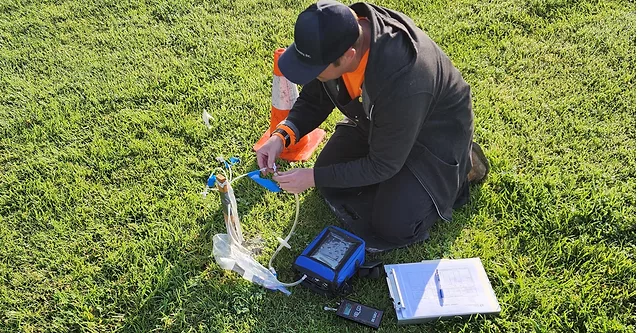The Golden State: A global leader in the vapor intrusion evaluation industry
May 9, 2023
The Golden State: A global leader in the vapor intrusion evaluation industry
May 9, 2023For more than 20 years, vapor intrusion evaluations have steadily become popular in various regions of the United States.
In the early 2000s, vapor intrusion (VI) evaluations began to become popular, as environmental professionals first focused on the migration of gasoline fuel additives, such as benzene, from subsurfaces into buildings.
From there, they evaluated chlorinated solvents like perchloroethylene (PCE), trichloroethene (TCE), carbon tetrachloride and 1,4-dioxane, all of which led to today’s primary focus: emerging contaminants or emerging constituents.
“Instead of specific constituents for VI, there’s an entirely new model of risk,” says James Robert, L.G., L.H.G., senior hydrogeologist at Salem Engineering Group, Inc. “If, for example, someone is out working on a jobsite, or they want to redevelop a jobsite from a gas station into a residential property, they have the risk of encountering contaminated soil, soil vapor and groundwater.”
According to Robert, in the 1990s and early 2000s, environmental professionals primarily tested for soil and groundwater contamination. When radon became a VI issue in the 1980s and 1990s, professionals began to test other chemicals that might migrate from soil vapor into indoor air, including benzene, ethylbenzene, toluene and xylene (benzene and ethylbenzene are the most important, as they’ve been proven to cause cancer).
“VI began to be used for virtually any type of volatile chemical you can think of, whether it was in soil, groundwater or even ambient air,” Robert explains. “In fact, California became the first state to screen indoor air levels, with regards to chemicals.”
As an example of California’s dedication to VI evaluations, the California Department of Toxic Substances Control (DTSC) and the California State Water Resources Control Board recently released its “Final Draft Supplemental Guidance: Screening and Evaluating Vapor Intrusion” report. In the document, a variety of factors, concerning vapor migration in subsurfaces through building foundations, were mentioned as “natural and human-caused”, including building conditions (such as its age, size and foundation type), climate (precipitation and pressure, among other issues) and HVAC operation[1].
The report also stresses that there is a variability in indoor air and subsurface vapor concentrations, leading to a high potential for false negatives and, in turn, the likelihood that “potential human health risks, associated with VI into indoor air, will be underestimated.”
In addition, the report mentions that “historically, practitioners and state regulators have used various approaches to assess vapor migration and predict if subsurface concentrations pose a risk to building occupants, thus resulting in potentially conceptually inconsistent VI assessment and risk management from site to site.”
Utilizing EPA analytical methods for direction
With this in mind, environmental consultants and professionals often work with sampling and analytical firms to facilitate the sampling and analysis associated with VI evaluations. Companies like H&P, Inc., which is located in Southern California, have developed subsurface sampling procedures, based on best practices that meet criteria set forth by several state and federal guidelines. According to Suzie Nawikas, operations manager for H&P, Inc, they “specialize in providing unbiased and defensible data in support of VI evaluations”, utilizing best sampling practices and numerous U.S. Environmental Protection Agency (EPA) analytical methods for direction.
For instance, her teammates will conduct an analysis of vapor and air samples while using “EPA Air Method, Toxic Organics – 15 (TO-15): Determination of Volatile Organic Compounds (VOCs) in Air Collected in Specially-Prepared Canisters and Analyzed by Gas Chromatography/Mass Spectrometry (GC/MS)”[2] as a guide.
According to the University of Bristol[3], “GC/MS is an instrumental technique, comprising a gas chromatograph (GC), coupled to a mass spectrometer (MS), by which complex mixtures of chemicals may be separated, identified and quantified.” Consequently, it’s “ideal for the analysis of the hundreds of relatively low molecular weight compounds found in environmental materials.”
Furthermore, environmental consultants and professionals can use the EPA’s “User’s Guide for Evaluating Subsurface Vapor Intrusion into Buildings”[4], as well as Section 313 of the EPA’s Emergency Planning and Community Right-to-Know Act of 1986 (EPCRA)[5]. Due to this section of the act, if certain facilities are manufacturing, processing or using toxic chemicals that have been listed by the EPCRA, they must report how many chemicals enter each environmental medium annually, along with any pollution prevention and recycling data they have for each chemical.
Although VI evaluations may appear to be quite complicated to onlookers, Nawikas and her teammates always attempt to conduct their VI assessments in a rather straightforward manner. First, they’ll insert tubing into the subsurface at a designated depth, using a drilling method. From there, they’ll remove the soil vapor (air entrained in the pore spaces) to analyze contaminants in laboratories.
“Of course, there is much more that goes into the details of obtaining the samples, but the general concept is simple,” Nawikas says.
At times, vapor samples are collected from beneath a building by drilling through its bottom floor and slab into the subsurface. However, some building owners don’t want environmental professionals to drill holes through their building’s floor.
“Therefore, many evaluations utilize holes that are drilled around the perimeter of the building to obtain a comparable estimate,” she states. “Likewise, vapor samples can be collected from below the space of a future building to predict any vapor issues that may be present.”
While collecting vapor samples, environmental professionals will focus on primary sources like drains, landfills, pipelines, sumps, tanks and waste ponds, which the DTSC and the California State Water Resources Control Board consider “release points of contamination”. They must also look at secondary sources: vapor forming chemicals (VFCs) that are transferred from a primary source “and occur in the subsurface as a non-aqueous-phase liquid (NAPL), absorbed-phase contamination or dissolved-phase contamination,” according to the DTSC and the California State Water Resources Control Board[6].
Moreover, as environmental professionals assess primary and secondary sources—along with vapor entry points (penetrations in building foundations or subsurface walls), preferential pathways (high-capacity pathways in which vapors are transported from subsurface sources to building foundations or the buildings themselves) and vapor conduits (pathways that have little or no resistance to vapor flow)—they must also consider EPA-recommended VI attenuation factors (AFs).
According to the DTSC and the California State Water Resources Control Board, AFs, which are site-specific, are obtained from mathematical models like the Johnson and Ettinger model, so they may not always be ideal when occupied buildings are screened for vapors. While screening buildings during VI evaluations, professionals should use five AFs: 0.0005 for groundwater associated with fines, 0.001 for generic groundwater, 0.03 for soil gas, 0.03 for subslab soil gas and 1 for crawl space gas[7].
“Originally, when the DTSC and the California State Water Resources Control Board released similar guidance in 2011 and 2015, they used an AF of 0.001, which means that soil vapor concentrations are assumed to decrease by a factor of 1,000 by the time they reach indoor air,” Robert says. “But, since 2021, they’ve been using an AF of 0.03 and now assume that VOC concentrations decrease by a factor of 30. As a result, if detectable concentrations of VOCs are identified now, it’s highly likely that they’ll be greater than their respective screening levels and exceed acceptable human health risks for that particular building.”
California: The hot spot for VI evaluations
Without question, California has been the leader in VI evaluations the last two decades, as “it drives the other states”, according to Robert. As an example of its influence, Salem Engineering Group Inc. has five offices in California alone, while H&P, Inc. is based in Carlsbad. Not to mention, The Golden State not only has the DTSC and the California State Water Resources Control Board, but several subdivisions of its regulatory agencies are focused on vapors, too. And it has created websites like EnviroStor[8] and GeoTracker[9], which anyone can use to determine which sites may have waste or may impact water quality, thereby inspiring other states to possibly follow suit down the road.
Yet, despite being considered the primary hot spot for VI evaluations, it’s certainly not the only one committed to these types of evaluations, as several other states have stringent environmental regulations as well, from Illinois, Massachusetts and Minnesota, to New York, Oregon and Washington.
“A lot of coastal states, along with states located on lakes, have strict environmental regulations, as well as their own rules,” Robert stresses. “But California is one of the most stringent, if not the most stringent, of all 50 states.”
As a result, organizations like H&P, Inc. may have clients located throughout the U.S., but the bulk of their services are in California. And they’ve had to learn how to adapt from one agency in California to the next, as each one has different VI evaluation guidelines.
“VI evaluations are prompted by local and state regulations, so some states may seem to be ‘hot spots,' when they’re actually just states with more regulations than others,” Nawikas says. “California's regulations do drive more VI evaluations than other states though.”
At the end of the day, some people wonder why VI evaluations are necessary at all. Why should environmental professionals take subsurface samples and extrapolate what they may equate to, in terms of the air in a building’s breathing space, when they can just take samples of the actual air instead?
In short, according to Nawikas, indoor air is the summation of influences from materials and products in buildings, outdoor air and subsurface vapors that travel into buildings.
“The other factors involved in the indoor air concentration make it very hard to verify the sources of breathing air’s contaminants, which also makes it very hard to determine how to improve it,” she concludes. “However, subsurface investigations, via VI evaluations, provide environmental professionals the information they need to assess—and potentially clean up—indoor air’s VI components.”
[1] “Final Draft Supplemental Guidance: Screening and Evaluating Vapor Intrusion”, California Department of Toxic Substances Control and the California State Water Resources Control Board, February 2023.
[2] “EPA Air Method, Toxic Organics - 15 (TO-15): Determination of Volatile Organic Compounds (VOCs) in Air Collected in Specially-Prepared Canisters and Analyzed by Gas Chromatography/Mass Spectrometry (GC/MS)”, EPA, 1999.
[3] “Gas Chromatography Mass Spectrometry (GC/MS)”, NERC Life Sciences Mass Spectrometry Facility, University of Bristol.
[4] “User’s Guide for Evaluating Subsurface Vapor Intrusion into Buildings”, EPA, Feb. 22, 2004.
[5] “Emergency Planning and Community Right-to-Know Act – Section 313”, EPA, August 2001.
[6] “Final Draft Supplemental Guidance: Screening and Evaluating Vapor Intrusion”, California Department of Toxic Substances Control and the California State Water Resources Control Board, February 2023.
[7] “Final Draft Supplemental Guidance: Screening and Evaluating Vapor Intrusion”, California Department of Toxic Substances Control and the California State Water Resources Control Board, February 2023.
[8] EnviroStor, State of California, 2023.
[9] GeoTracker, State of California, 2023.


.webp?t=1683228544)
.webp?t=1683228577)
.webp?t=1683228607)

.webp?t=1683228673)

.webp?t=1683228761)
.webp?t=1683228813)
.webp?t=1683228847)
.webp?t=1683228873)
.webp?t=1683228902)

.webp?t=1683228984)

.webp?t=1683229050)
.webp?t=1683229090)
.webp?t=1683229155)

.webp?t=1683229261)





.webp?t=1683229471)

